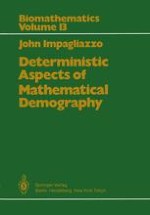Mathematical Demography, the study of population and its analysis through mathematical models, has received increased interest in the mathematical com munity in recent years. It was not until the twentieth century, however, that the study of population, predominantly human population, achieved its math ematical character. The subject of mathematical demography can be viewed from either a deterministic viewpoint or from a stochastic viewpoint. For the sake of brevity, stochastic models are not included in this work. It is, therefore, my intention to consider only established deterministic models in this discussion, starting with the life table as the earliest model, to a generalized matrix model which is developed in this treatise. These deterministic models provide sufficient de velopment and conclusions to formulate sound mathematical population analy sis and estimates of population projections. It should be noted that although the subject of mathematical demography focuses on human populations, the development and results may be applied to any population as long as the preconditions that make the model valid are maintained. Information concerning mathematical demography is at best fragmented.
